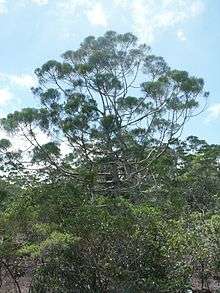Gymnostoma
Gymnostoma is a genus of about eighteen species of trees and shrubs, constituting one of the four genera of the plant family Casuarinaceae.[1][2][3][4] The species grow naturally in the tropics, including at high altitudes having temperate climates, in forests in the region of the western Pacific ocean and Malesia. In New Caledonia, published botanical science describes eight species found growing naturally, which botanists have not found anywhere else (endemics).[5] Additional species have been found across Burma, Sumatra, Borneo, the Philippines, Sulawesi, Ambon Island, the Moluccas, New Guinea, the Bismarck Archipelago, the Solomon Islands, and one endemic species each in Fiji and the Wet Tropics of Queensland, Australia.
| Gymnostoma | |
|---|---|
 | |
| Gymnostoma deplancheanum, very old specimen, near Prony, New Caledonia | |
| Scientific classification | |
| Kingdom: | Plantae |
| Clade: | Tracheophytes |
| Clade: | Angiosperms |
| Clade: | Eudicots |
| Clade: | Rosids |
| Order: | Fagales |
| Family: | Casuarinaceae |
| Genus: | Gymnostoma L.A.S.Johnson[1][2] |
| Species | |
|
See text | |
_002.jpg)
_001.jpg)
The genus was first scientifically described by Lawrie A. S. Johnson in 1980.[1] Many of the Gymnostoma species combinations of names (binomials) were described by him in 1982.[3] As of 2013, a global total of eighteen species have been found and described.[6][7]
The majority of the species grow in rainforests, in the habitats of open, sunny, long-term gaps, from river bank (riparian) situations through to mountain top situations. In New Caledonia two endemic species G. chamaecyparis and G. deplancheanum have specialised adaptations, growing in wet "shrub maquis and paraforest maquis formations. G. chamaecyparis is associated with hypermagnesian soils (hypermagnesian inceptisol) below 600 m altitude at the base of ultramafic massifs. G. deplancheanum occurs on ferralitic ferritic desaturated hardpan or gravelly soils (oxisol) on the southern massif at altitudes between 200 and 1,000 m".[5]
Species
14 formally described species, meanwhile about four more species apparently have been found in New Guinea and collections preserved but awaiting formal description.[8]
- Gymnostoma australianum L.A.S.Johnson – Australia endemic[9]
- Gymnostoma chamaecyparis (J.Poiss.) L.A.S.Johnson – New Caledonia endemic[5] (Fr)
- Gymnostoma deplancheanum (Miq.) L.A.S.Johnson – New Caledonia endemic[5] (Fr)
- Gymnostoma glaucescens (Schltr.) L.A.S.Johnson – New Caledonia endemic[5]
- Gymnostoma intermedium (J.Poiss.) L.A.S.Johnson – New Caledonia endemic[5]
- Gymnostoma leucodon (J.Poiss.) L.A.S.Johnson – New Caledonia endemic[5]
- Gymnostoma nobile (Whitmore) L.A.S.Johnson – Borneo, Philippines
- Gymnostoma nodiflorum (Thunb.) L.A.S.Johnson – New Caledonia endemic[5]
- Gymnostoma papuanum (S.Moore) L.A.S.Johnson – New Guinea, Solomon Islands
- Gymnostoma poissonianum (Schltr.) L.A.S.Johnson – New Caledonia endemic[5]
- Gymnostoma rumphianum (Miq.) L.A.S.Johnson – Sulawesi, Moluccas, Ambon Island (Indonesia), Philippines, Bismarck Archipelago
- Gymnostoma sumatranum (Jungh. ex de Vriese) L.A.S.Johnson – Burma, Sumatra, Borneo, Java, Sulawesi (Indonesia), W New Guinea, Philippines
- Gymnostoma vitiense L.A.S.Johnson – Fiji endemic
- Gymnostoma webbianum (Miq.) L.A.S.Johnson – New Caledonia endemic[5]
References
- Johnson, Lawrie A. S. (1980). "Notes on Casuarinaceae". Telopea. (Online page archive version, link via APNI Gymnostoma ref's). 2 (1): 83–84. doi:10.7751/telopea19804114. Archived from the original (PDF) on 24 December 2013. Retrieved 15 November 2013.
- "Gymnostoma%". Australian Plant Name Index (APNI), Integrated Botanical Information System (IBIS) database (listing by % wildcard matching of all taxa relevant to Australia). Centre for Plant Biodiversity Research, Australian Government. Retrieved 15 Nov 2013.
- Johnson, Lawrie A. S. (23 December 1982). "Notes on the Casuarinaceae II" (PDF). Journal of the Adelaide Botanic Gardens. 6 (1): 73–87. Retrieved 15 November 2013.
-
Johnson, Lawrie A. S. (1988). "Notes on Casuarinaceae III: The new genus Ceuthostoma". Telopea. (Online page archive version, link via APNI Ceuthostoma ref's). 3 (2): 133–137. doi:10.7751/telopea19884801. Archived from the original (PDF) on 10 June 2015. Retrieved 15 November 2013.
A synoptic key for the four genera of the family is given.
- Jaffré, Tanguy; Gauthier, Daniel; Rigault, Frédéric; McCoy, Stéphane (1994). ORSOM (Nouvelle-Calédonie). "Les Casuarinacées endémiques - Caractéristiques écologiques et nutritionnelles" [The Endemic Casuarinaceae (of New Caledonia) – Ecological and Nutritional Characteristics] (PDF). Bois et Forêts des Tropiques (in French and English) (242 New Caledonia Special): 31–43.
- Hyland, B. P. M.; Whiffin, T.; Zich, F. A.; et al. (Dec 2010). "Factsheet – Casuarinaceae". Australian Tropical Rainforest Plants (6.1, online version RFK 6.1 ed.). Cairns, Australia: Commonwealth Scientific and Industrial Research Organisation (CSIRO), through its Division of Plant Industry; the Centre for Australian National Biodiversity Research; the Australian Tropical Herbarium, James Cook University. Retrieved 15 November 2013.
- "Gymnostoma". Flora of Australia Online. Department of the Environment and Heritage, Australian Government.
- Conn, Barry J. (2013) [2008+]. "Gymnostoma" (Online, from pngplants.org/PNGCensus). Census of Vascular Plants of Papua New Guinea. Retrieved 15 November 2013.
- Hyland, B. P. M.; Whiffin, T.; Zich, F. A.; et al. (Dec 2010). "Factsheet – Gymnostoma australianum". Australian Tropical Rainforest Plants (6.1, online version RFK 6.1 ed.). Cairns, Australia: Commonwealth Scientific and Industrial Research Organisation (CSIRO), through its Division of Plant Industry; the Centre for Australian National Biodiversity Research; the Australian Tropical Herbarium, James Cook University. Retrieved 15 November 2013.